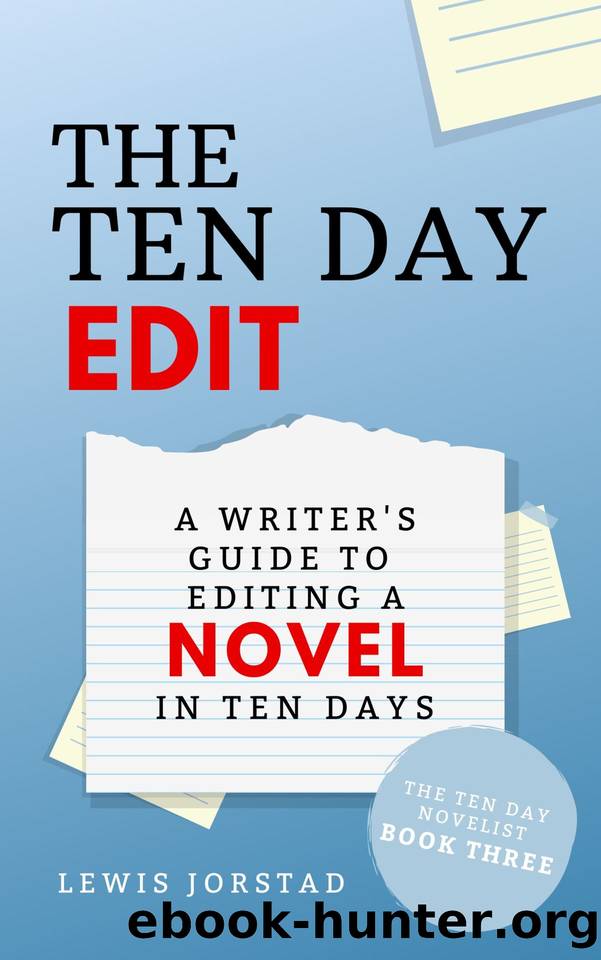The Ten Day Edit: A Writer's Guide to Editing a Novel in Ten Days (The Ten Day Novelist Book 3) by Jorstad Lewis

Author:Jorstad, Lewis [Jorstad, Lewis]
Language: eng
Format: epub
Publisher: The Novel Smithy, LLC
Published: 2020-04-28T00:00:00+00:00
On to Day Five!
7
Day Five: Confronting Your Scenes
When most people think of the editing process, they think of it in terms of drafts: first drafts, second drafts, third, and maybe even fourth drafts. However, a lot of the time, writers aren’t really sure what the difference is between those drafts. Sure, the first draft is easy—it’s your story in its roughest form, with no editing completed. But what exactly marks your second draft, or your third?
What’s the difference?
Well, a lot of it comes down to the level of editing you’ve completed. Days One through Four of this challenge were all about working up to your second draft, or finishing your big-picture edits. This was about story structure, characters, worldbuilding, and your novel as a whole.
Now that you’re moving into Day Five, you’ll have officially finished those big-picture edits and your manuscript will be what most people would consider a second draft. Your core story is strong, and you finally have the foundation you need to begin polishing the beat by beat details of your novel. This will be your mid-level editing, encompassing your individual scenes, the transitions between them, and your novel’s chapters—essentially, the smaller, still structural problems you no doubt noticed while revising your draft during the First Rest.
Of course, we won’t tackle all of that at once.
Before we can dig into things like transitions or chapters, we need to make sure your story is compelling every step of the way, starting with your scenes. By the end of today, you’ll be halfway to a finished novel, so welcome back! Lets get right into things.
The Requirements of a Scene
Now that you’ve finished your big-picture editing, your novel should be in a much better place than it was when we started. However, you’ll probably still have some smaller elements of your story that need attention—specifically your scenes.
As you worked through your game plan during the First Rest, you probably noticed some scenes that just didn’t work, even if you weren’t sure why at the time. Fortunately, today is when we’ll dive in and start putting those problem scenes back on track.
To get started, open up your reverse outline and flip to your scene timeline. Find any of the scenes you marked as problem scenes earlier on and transfer their names and details to a blank page in your reverse outline. Label this page accordingly, so you won’t get it confused with your scene timeline down the road. Though that might seem impossible, trust me—it happens! This dedicated page will help keep you organized as we go, and will give you a better idea of how many scenes need substantial work.
Of course, it’s entirely possible you missed some problem scenes while revising your first draft. To account for this, we’re going to run a quick test before we dive into analyzing these scenes.
First up, to catch any problem scenes you may have missed, scan through your scene timeline and ask yourself these questions for each scene:
Does my protagonist have a clear
Download
This site does not store any files on its server. We only index and link to content provided by other sites. Please contact the content providers to delete copyright contents if any and email us, we'll remove relevant links or contents immediately.
Kiss My Asterisk by Jenny Baranick(1215)
The Only Grammar Book You'll Ever Need: A One-Stop Source for Every Writing Assignment by Thurman Susan(1205)
Writing CopyFor Dummies by Jonathan Kranz(1196)
BRADBURY, Ray by Zen in the Art of Writing (pdf)(977)
English Verb Tenses Up Close by Mark Lester(951)
Writing Fiction by Gotham Writers' Workshop(918)
The Copywriter's Handbook by Robert W. Bly(795)
It's Never Too Late to Begin Again by Julia Cameron(777)
crafting dynamic dialogue by editors writers digest(748)
Telling Lies for Fun & Profit by Lawrence Block & Sue Grafton(747)
The Psychology Workbook for Writers by Darian Smith(742)
How to Not Write Bad by Ben Yagoda(717)
The Grammar Devotional by Mignon Fogarty(716)
The Book of Ruby(681)
100 Successful College Application Essays by The Harvard Independent(666)
Writing Tools: 50 Essential Strategies for Every Writer by Roy Peter Clark(651)
Steal This Plot: A Writer's Guide to Story Structure and Plagiarism by William Noble & June Noble(626)
How to write Science fiction and Fantasy by Orson Scott Card(614)
Inland by Gerald Murnane(611)
